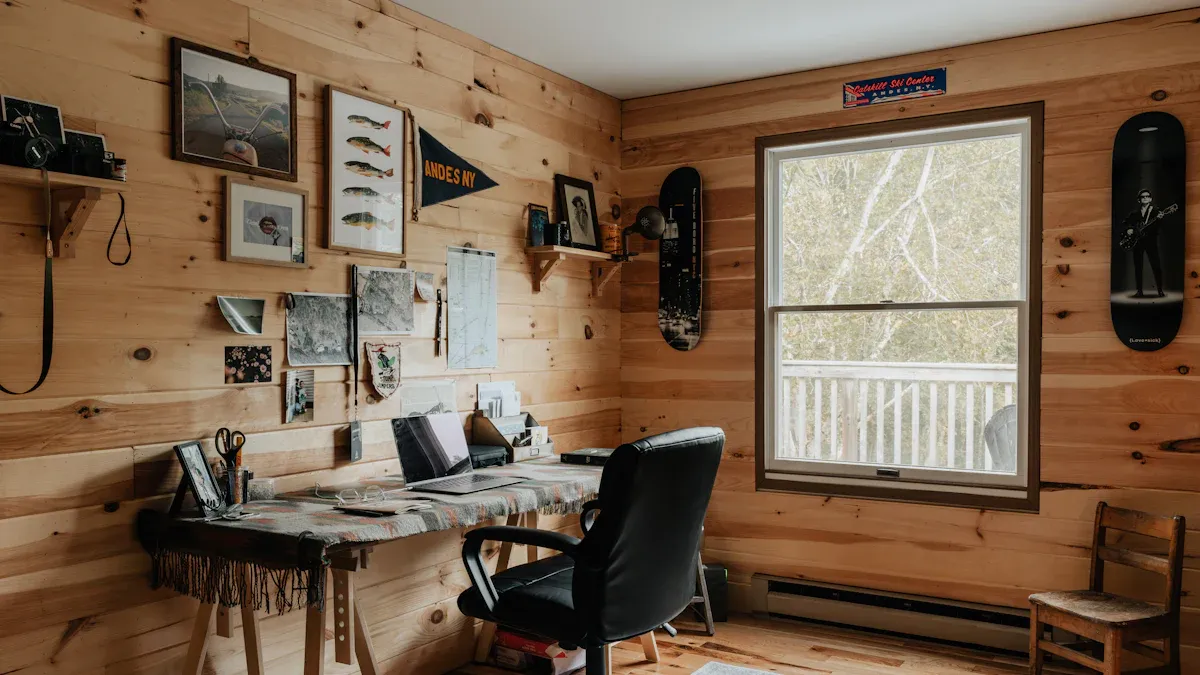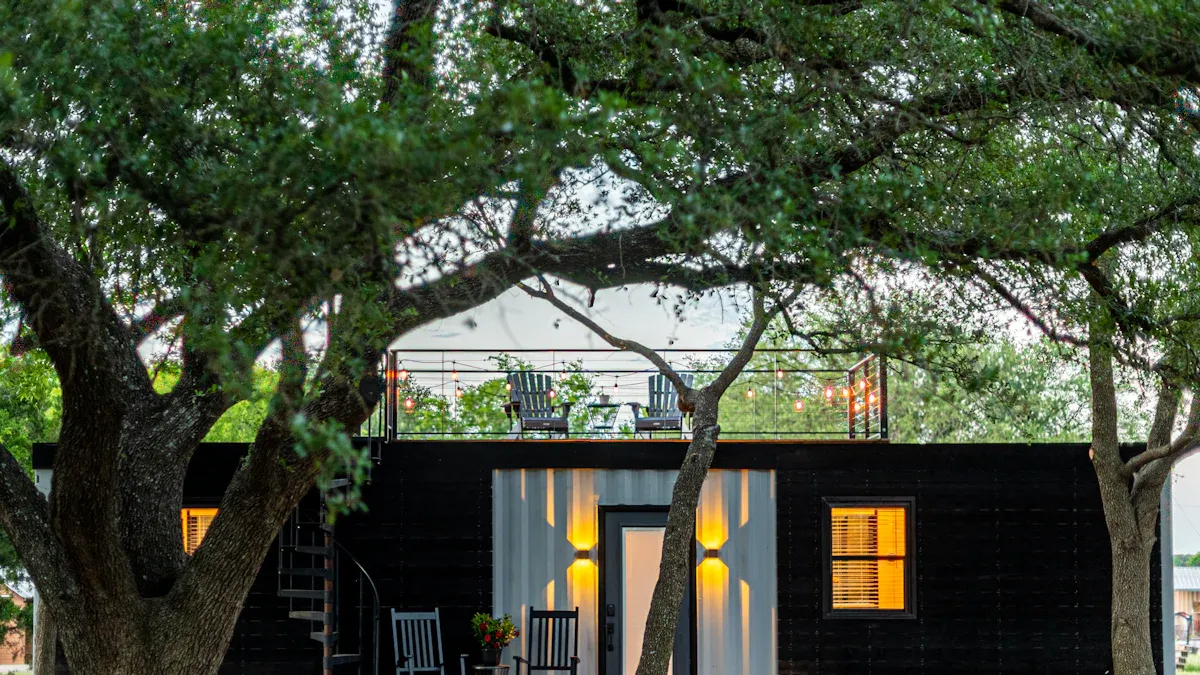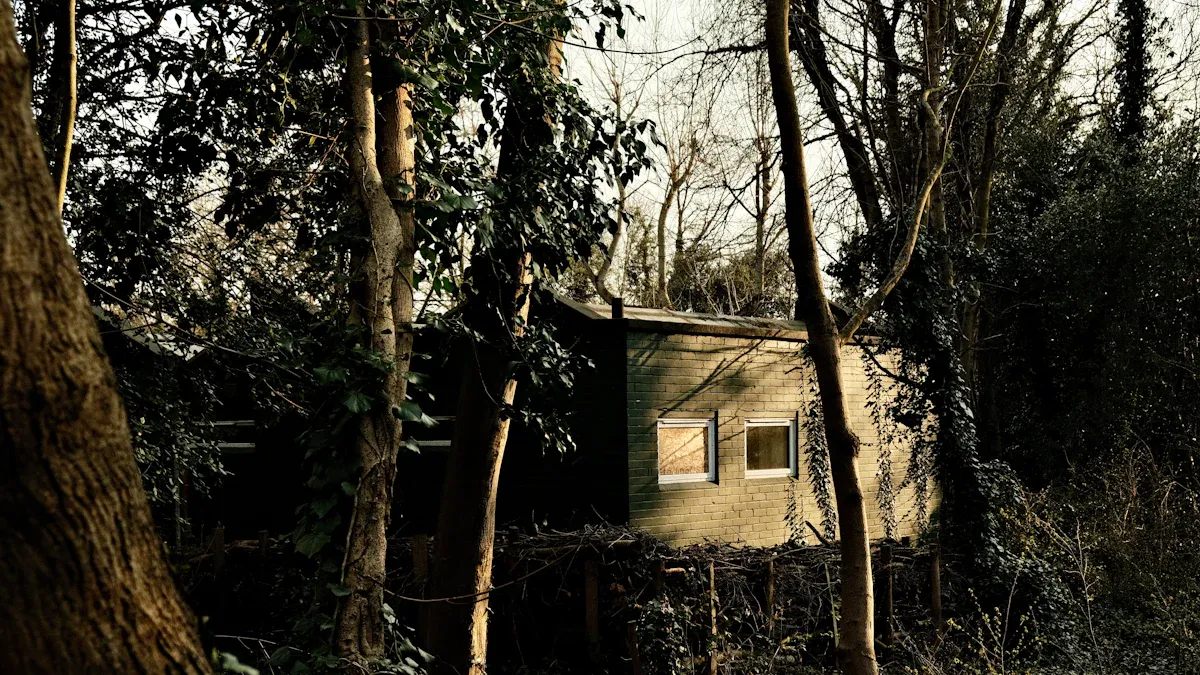
Prefab houses offer a smart way to set up a home office in the wilderness. They are affordable and quick to install, making them ideal for remote locations. For example, modular construction can cut costs by 20%, while energy-efficient designs reduce heating needs by 30%. These homes combine practicality with comfort, even in challenging environments. Whether it’s a cozy prefab house or a futuristic space capsule house, they create a peaceful workspace surrounded by nature. Affordable prefab housing ensures that remote workers can enjoy both productivity and serenity without breaking the bank.
Benefits of Prefab Houses for Remote Work
Quick and Easy Installation
Prefab houses are known for their rapid installation process, making them perfect for remote work setups. Unlike traditional construction, which can take months or even years, prefab homes are ready in a fraction of the time.
| Construction Method | Average Timeframe |
|---|---|
| Traditional Construction | Months to years for planning and construction |
| Prefabricated Homes | Days for planning, weeks for construction and assembly |
This speed is possible because prefab houses are built in controlled factory environments. Workers assemble the components on-site, minimizing delays caused by weather or material shortages. For remote workers, this means less waiting and more time enjoying their new workspace in nature.
Cost-Effectiveness Compared to Traditional Construction
Prefab houses are a budget-friendly alternative to traditional construction. Studies show that they can be up to 20% cheaper due to reduced material waste and efficient factory production.
- Prefabricated housing in Cyprus is €148.33/m² cheaper than conventional construction.
- The cost difference between prefab units and timber-frame alternatives is €46.57/m².
Additionally, prefab homes avoid common cost overruns caused by weather delays or fluctuating material prices. For remote workers, this affordability ensures they can create a functional and comfortable office without overspending.
Customization Options for a Personalized Workspace
Prefab houses offer endless customization possibilities, allowing remote workers to design a workspace that suits their needs.
- Exterior and Interior Finishes: Choose from wood, metal, or other materials.
- Flexible Floor Plans: Adjust layouts to fit your lifestyle.
- Smart Home Features: Add technologies like automated lighting or climate control.
- Renewable Energy Add-ons: Install solar panels for energy efficiency.
Thanks to computer-aided design, users can actively participate in the customization process. This involvement ensures the final product feels personal and tailored to their work style.
Eco-Friendly and Sustainable Building Practices
Prefab houses are an eco-conscious choice for remote workspaces. Their construction process minimizes waste and uses sustainable materials. Performance metrics like daylight autonomy and useful daylight illuminance ensure these homes maximize natural light, reducing energy consumption.
| Metric | Description |
|---|---|
| Daylight Autonomy | Measures the percentage of a space that receives adequate daylight throughout the year. |
| Annual Sunlight Exposure | Indicates the amount of direct sunlight a space receives, expressed as a percentage of the area. |
| Useful Daylight Illuminance | Assesses the level of useful daylight in a space, ensuring adequate lighting for activities. |
By choosing prefab houses, remote workers contribute to a greener planet while enjoying a sustainable and efficient workspace.
Key Features to Look for in Prefab Houses for Home Offices

Insulation and Climate Control for All Seasons
A comfortable workspace starts with proper insulation. Prefab houses designed for home offices often use high-quality, sustainable materials to maintain a stable indoor climate. This tight thermal envelope keeps heat inside during winter and blocks it out during summer, reducing energy costs.
- Energy-efficient prefab homes rely on advanced insulation techniques.
- Materials like spray foam or rigid panels ensure year-round comfort.
- High-performance windows minimize heat loss and improve energy efficiency.
These features make prefab houses a practical choice for remote workers who need a cozy office in any season.
Adequate Space for Work and Storage
A functional home office requires enough room for work essentials and storage. Prefab houses offer flexible layouts to meet these needs. Workers can choose designs with built-in shelves, cabinets, or even loft spaces for extra storage.
Tip: Modular designs allow users to expand their workspace later if needed.
This adaptability ensures that the office remains organized and clutter-free, even in compact spaces.
Reliable Power and Internet Connectivity
Reliable power and internet are essential for remote work. Prefab houses can integrate solar panels and energy-efficient appliances to ensure uninterrupted power. For internet, satellite solutions like Ka-Band VSAT provide speeds up to 50MBps, even in remote areas.
- Easy-to-deploy systems make connectivity accessible.
- These setups support video calls, file uploads, and other online tasks.
With these features, prefab houses enable seamless work in the wilderness.
Durable Materials for Remote Environments
Prefab houses built for remote locations use durable materials to withstand harsh conditions. Modular designs for Arctic climates, for example, reduce heating energy use by 30%. Tight construction and energy-efficient designs also lower maintenance costs.
- Materials like steel or treated wood resist extreme weather.
- Precision factory builds ensure better durability and energy retention.
These features make prefab houses a long-lasting solution for remote workspaces.
Steps to Set Up Prefab Houses for Remote Work
Choosing the Right Location
Selecting the perfect spot for your prefab house is crucial. The location should balance accessibility, natural beauty, and practicality. For instance, modular homes in Alaska’s remote villages use 50% less energy than traditional buildings, proving their efficiency in extreme conditions. Similarly, the Nunavik Project in Northern Quebec showed a 30% reduction in heating energy use with modular homes.
| Project Name | Key Findings |
|---|---|
| Alaska’s Remote Villages | Modular homes use 50% less energy than traditional buildings, showcasing significant efficiency improvements. |
| Nunavik Project in Northern Quebec | Modular homes reduce heating energy use by up to 30% compared to conventional homes, demonstrating their effectiveness in extreme conditions. |
When choosing a location, consider factors like climate, terrain, and proximity to essential utilities. A well-chosen site ensures comfort and efficiency for your remote workspace.
Selecting the Best Prefab Model for Your Needs
Prefab houses come in various designs, so picking the right model depends on your specific requirements. Think about the size of your workspace, the number of rooms you need, and any additional features like solar panels or smart home technology. Modular designs allow for flexibility, so you can expand or modify your home office as your needs evolve.
Tip: Look for models that offer energy-efficient features and durable materials to withstand the challenges of remote environments.
Preparing the Site for Installation
Proper site preparation ensures a smooth installation process. Before setting up your prefab house, make sure the site meets essential preconditions:
- Availability of water and sewer lines.
- Access to electric and gas connections.
- A level and stable foundation for the structure.
These steps not only streamline the installation but also prevent potential issues down the line. A well-prepared site guarantees that your prefab house will function efficiently from day one.
Furnishing and Equipping Your Home Office
A well-furnished home office boosts productivity and comfort. Ergonomic furniture, like adjustable chairs and desks, can reduce workplace injuries by 25%, according to OSHA. Employees with proper ergonomic setups also take 10% fewer sick days and are twice as productive.
- Invest in ergonomic chairs and desks to support healthy posture.
- Add proper lighting to reduce eye strain during long work hours.
- Include storage solutions to keep your workspace organized.
By equipping your prefab house with the right tools and furniture, you create a workspace that promotes both health and efficiency.
Challenges of Using Prefab Houses in Remote Locations
Ensuring Reliable Internet Access in Remote Areas
Staying connected in remote areas can be tricky, but modern solutions make it possible. Technologies like Ka-Band VSAT have proven effective in delivering reliable internet. This system supports speeds of up to 50MBps for downloads and 15MBps for uploads, even in isolated locations. For instance, St. Joseph’s College successfully used this technology to host remote learning sessions for multiple users.
Tip: Satellite internet is a great option for remote prefab homes. It ensures seamless video calls and file sharing, keeping work uninterrupted.
Managing Power Supply and Energy Needs
Energy efficiency is crucial for prefab houses in remote areas. Advanced insulation materials and Energy Star-rated appliances significantly reduce heating and cooling needs. These features lower utility bills and make prefab homes a smart choice for energy management. Additionally, smart monitoring systems help track energy usage, ensuring optimal performance.
Prefab designs also incorporate renewable energy options like solar panels. These systems provide a sustainable power source, making them ideal for off-grid locations.
Dealing with Weather and Environmental Factors
Weather can pose challenges, but prefab houses are built to withstand harsh conditions. Their construction minimizes air infiltration and heat loss, thanks to airtight building envelopes and superior insulation.
| Construction Method | Impact of Weather Conditions |
|---|---|
| Traditional Construction | Highly affected by adverse weather conditions |
| Prefabricated Homes | Minimal impact, primarily during assembly phase |
These features ensure durability and energy efficiency, even in extreme climates. Prefab homes in Arctic regions, for example, use 50% less energy than traditional buildings.
Navigating Local Building Codes and Permits
Building codes and permits vary by location, and navigating them can be a challenge. Remote areas often have unique regulations that require careful research. It’s essential to consult local authorities and ensure compliance before installation.
Note: Partnering with experienced prefab housing providers can simplify the process. They often handle permits and ensure the home meets all legal requirements.
Inspiring Examples of Prefab Houses for Remote Work

Case Study: A Minimalist Office in the Mountains
Imagine working in a serene mountain setting with a minimalist prefab office. This design focuses on simplicity and functionality, blending seamlessly with the natural surroundings. Prefab houses in mountain regions often prioritize energy efficiency and daylighting to create a comfortable workspace.
| Performance Metric/Design Outcome | Description |
|---|---|
| Energy Efficiency | Prefabricated housing systems enhance energy efficiency by minimizing air infiltration and heat loss. |
| Daylighting | Passive solar features optimize natural light, reducing the need for artificial lighting. |
| Cost Considerations | Prefab systems balance cost efficiency with effective building systems. |
This type of office offers a peaceful environment for focused work while reducing energy costs. It’s a perfect example of how prefab houses can combine practicality with beauty.
Case Study: A Solar-Powered Workspace in the Desert
A solar-powered prefab workspace in the desert showcases innovation and sustainability. These homes use solar panels to harness the abundant sunlight, providing a reliable energy source. The design often includes reflective materials to keep interiors cool and energy-efficient windows to reduce heat gain.
This setup allows remote workers to stay productive while minimizing their environmental impact. The desert’s vast, open landscape also inspires creativity, making it an ideal location for professionals seeking solitude and inspiration.
Case Study: A Forest Retreat for Creative Professionals
A forest retreat offers a tranquil escape for creative professionals. Prefab houses in wooded areas often feature large windows and open layouts to connect the interior with the surrounding greenery. These designs use sustainable materials like reclaimed wood, ensuring harmony with the environment.
This type of workspace encourages creativity by immersing workers in nature. The calming sounds of the forest and the fresh air create a perfect setting for brainstorming and artistic endeavors.
Prefab houses offer a smart way to create remote workspaces. They save time with faster construction and reduce costs with energy-efficient designs. Many use recycled materials, producing minimal waste. Their affordability and sustainability make them a top choice for remote workers who want to balance productivity with nature’s peace.
Did you know? Prefab homes cut construction time in half and produce only 1% waste, making them an eco-friendly solution for modern living.
FAQ
What is a prefab house?
Prefab houses are homes built in factories and assembled on-site. They save time, reduce waste, and offer customizable designs for various needs.
Can prefab houses work in extreme climates?
Yes! Prefab houses use durable materials and advanced insulation. They stay comfortable in hot deserts, cold mountains, or humid forests.
How do prefab houses support remote work?
Prefab houses provide quiet spaces, reliable internet, and ergonomic setups. They create productive environments in peaceful, natural settings.
